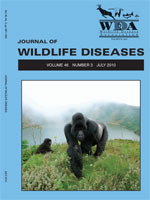Electrocardiographic (ECG) variables were measured in 22 healthy, free-ranging brown bears (Ursus arctos) anesthetized with a combination of medetomidine, tiletamine, and zolazepam during research and management operations in south-central Sweden. Six-limb lead ECGs and the base-apex lead were recorded. Morphologies, amplitudes, rhythms, and durations of P waves, PQ intervals, QRS complexes, T waves, QT intervals, and QT intervals corrected for heart rate (QTc) were calculated from the base-apex lead. The mean electrical axis (MEA) for each individual was approximated in the frontal plane from the heights of R waves in leads I (X axis) and aVF (Y axis). All 22 bears had sinus rhythms and 10 of them had respiratory sinus arrhythmia. Heart rates ranged from 43 to 103 beats per minute and were independent of body mass. The MEA was 78.6 (±5.5) degrees. Some bears had strikingly peaked T waves, and many had pronounced notching (high frequency components) to the QRS complex. This information contributes to the limited data base of electrocardiography for brown bears and elucidates ECG similarities with other species in the order Carnivora.
How to translate text using browser tools
1 July 2010
BASELINE NORMAL VALUES AND PHYLOGENETIC CLASS OF THE ELECTROCARDIOGRAM OF ANESTHETIZED FREE-RANGING BROWN BEARS (URSUS ARCTOS)
A. Rae Gandolf,
Åsa Fahlman,
Jon M. Arnemo,
James L. Dooley,
Robert Hamlin
ACCESS THE FULL ARTICLE

Journal of Wildlife Diseases
Vol. 46 • No. 3
July 2010
Vol. 46 • No. 3
July 2010
bear
ECG
electrocardiogram
heart
T wave
Ursus arctos




